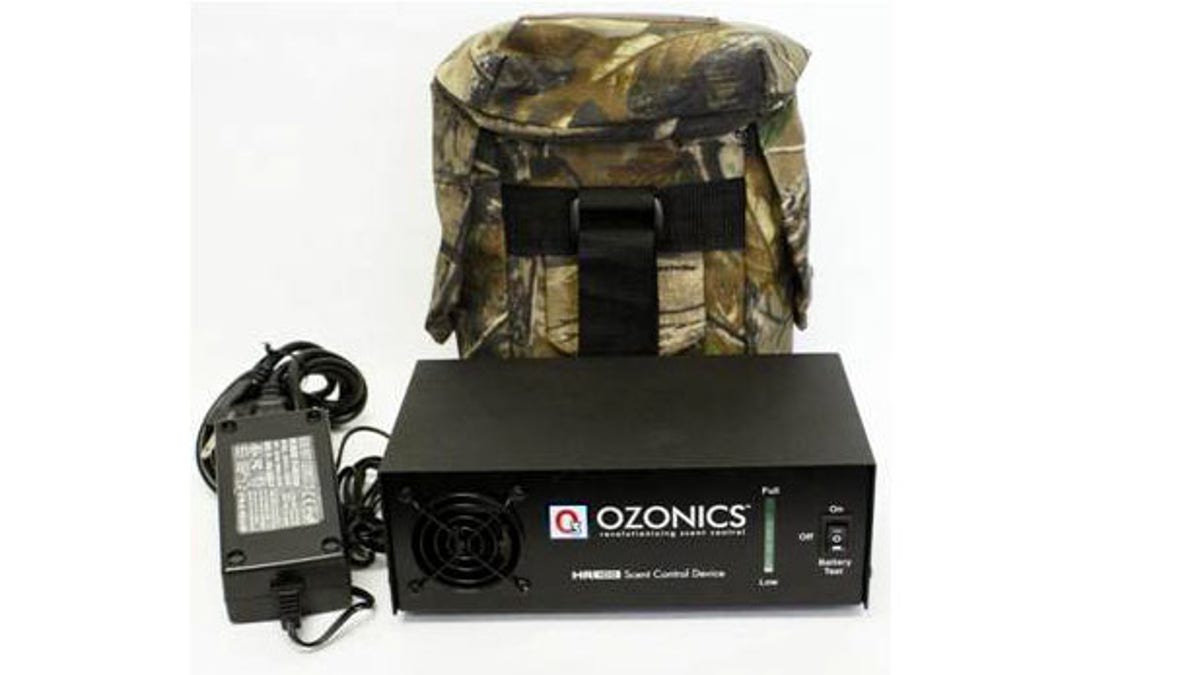
Security experts say the Ozonics HR-100 can easily mask bomb-making activity. (Ozonics LLC)
Would-be homicide bombers looking to skirt the keen noses of bomb-sniffing dogs can find everything they need at their local hunting store.
There, for about $300, they can buy a compact ozone machine that hunters use to mask human smells. It's a fairly low-tech device that will enable them to walk undetected past the K-9 units stationed to sniff out explosives at airports, train stations and bus depots.
Recent tests run by the FBI and New York’s Metropolitan Transportation Authority Police Department in collaboration with a private security company concluded that the inexpensive ozone machines have the potential to mask explosives completely.
The results of the tests, a summary of which was dated April 7, were included in a Canadian intelligence report obtained by FoxNews.com.
“Preliminary testing on odor mitigating devices — instruments that have the capability to eliminate human, explosives, and drug odors — reveals vulnerabilities to U.S. explosives discovery capabilities," the report states. "FBI field office, private security company, and Rail Transit Authority tests have determined that odor mitigating devices have the potential to completely mask explosives odors from canine detection.”
“Although there is no current information indicating any imminent threat, criminal groups, such as drug traffickers and terrorists, may seek out odor mitigation devices for operational use, such as concealment and transportation of illegal drugs or explosives. This is based on historical patterns of interest in concealment techniques and the low cost and wide proliferation of mitigation devices
Ozone eliminates odors by destroying — not masking — bacteria, germs and viruses. The use of ozone in heavy-duty cleaning products is nothing new, but a Texas-based company called Ozonics, which was founded by a group of hunters, has changed the game by making an ozone device portable, according to the intelligence report.
“Eliminating human scent is one of the most important factors in successful hunting," the company's Web site says. "With Ozonics’ new product, the HR-100 (Hunting Revolution 100), hunters can productively hunt game without animal detection. Field tests reveal that elk, deer and hogs approached within five feet of a properly camouflaged hunter downwind without detecting the hunter’s scent. No special clothing. No cover sprays. No scents.”
The device measures 8 3/4 x 4 7/8 x 3 3/8 inches, weighs about 5 pounds and comes in its own camouflaged-patterned bag. It’s perfectly legal, and it’s sold in hunting stores across the country; there are retailers that sell it within miles of New York City’s metro rail and subway systems. There are no limits to the number purchased, and there is no record of a sale unless the buyer purchases a warranty.
One of the partners of Ozonics LLC, who asked to have his name withheld, said he’d received numerous calls from local and federal law enforcement about the device.
He said Ozonics' founders, all of whom have medical or chemical or science backgrounds, formed the company in 2007 to provide hunters with a way to mask their body odor while hunting. The idea was to make a portable product that could be placed in the field above a hunter’s head so that animals would not detect the scent of a human.
When they applied for their patent, he said, they made sure to include their concerns about the product's potential impact.
“People always ask, “If it fooled the deer’s nose then what other kind of noses could it fool?”" he said.
“This can be used for nefarious purposes that can be very dangerous,” he said. “A terrorist can use this to mask any number of illegal activities.”
Explosive detection is highly specific and targeted, and dogs are trained to pick up specific scents undetectable to humans — particles so small they’re measured in parts per billion or trillion. In that way, ozone products could render an explosive element undetectable by the standard metrics used in explosive detection.
Mike White, the director of training for Michael Stapleton Associates and a former head of the NYPD bomb squad, said the device could work in ways that were never intended.
“The odor device could reduce your probability of detecting the sample because it doesn’t mask the odor, it removes it,” he said.
Still, he doesn’t consider the ozone product a real threat, because detecting odor is only one method for discovering explosives. While bomb squad dogs are sniffing around, there’s usually another kind of test taking place at the same time. So, even if an explosive device makes it past the dogs, it's unlikely to evade the other tests being conducted at the same time. For example, authorities who accompany the dogs often carry handheld electronic detection devices as well.
Former NYPD detective Dr. Charles Lieberman, a professor in the Department of Criminal Justice at the University of New Haven, agrees that these ozone products just confirm what is already known: bomb sniffing dogs are more effective when used in conjunction with electronic devices.
“I. Charles Faddis, a former CIA operations officer who was the head of the CIA's weapons of mass destruction terrorism unit, agrees that these products aren’t a sure way to evade detection and that they just highlight the ongoing problems with the current state of airport and subway security.
“The biggest issue with dogs is that there are never enough of them,” he said. “No matter what we’re talking about, there’s never going to be enough screening.”
Plus, there are so many other more serious issues related to securing New York's vulnerable subway system.
“They don’t even have working cameras in the subways,” White said.

